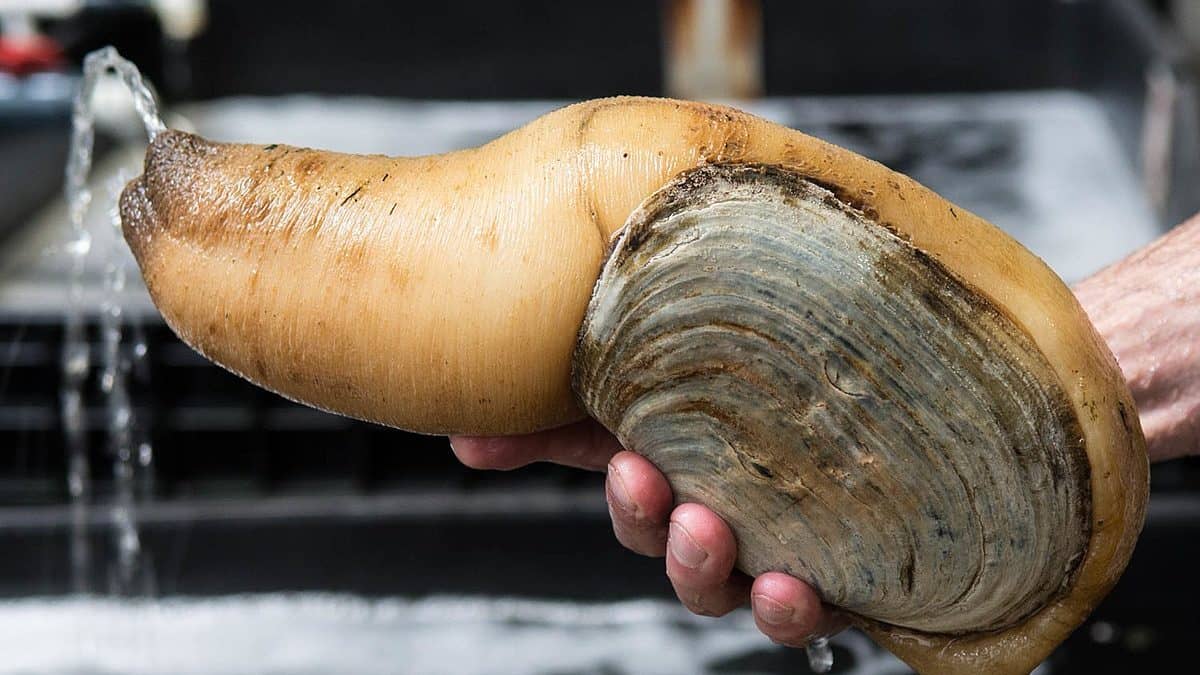Deep—and I’m talkin’ deep—under the sandy shores of the Pacific Northwest lives a unique looking creature that’s attracting attention across the world. The geoduck may look a little funny, but this clam isn’t just any delicacy: it’s a ticket to survival for many!
Whatever your home is known for—whether it be shea nuts, corn, maple syrup, or in this case, a giant clam—we tend to rally around it. It’s a source of pride, something unique to us. And when the world finds out about what we have and decide that they want in on it too, we’re able to invest the profits back into our local communities!
For the Native American communities living on the west coast of North America, the geoduck (pronounced “gooey-duck”) has been a part of their traditions for generations. Now, because of their growing popularity in Asia, they’re helping to bring more critical resources into their communities! 1But what goes into making this possible isn’t just a story that celebrates our natural resources. At the same time, we’re celebrating the amazing lengths we’ll go through to protect them. It may just have you thinking of what’s around you in a new way. Because one thing is for sure: this clam has connected and inspired a lot of people already.

Weighing in at up to 14 pounds, living for over 150 years 2, and armed with a siphon that looks like it would be right at home on an elephant’s face, geoducks are one interesting species of clam.
And while they may be tasty, there’s a catch. By no means are geoducks easy to cultivate, and their populations aren’t regenerating as we hope they would. So, we’re taking a look at the lives of these clams, the people who rely on them, why they’re so popular in China, and what’s being done to protect them!
In order to get the geoduck from the grounds of the Pacific Northwest to plates in Asia, it requires a lot of different people to care about this single clam. Because of this complexity, we’re about to hear a riveting tale with many chapters—connecting a diverse group of minds and skills to support traditions, provide life-saving resources, conserve a species, and end up creating a delicious meal.
This awesome video from AJ+ brings us to Washington state to walk us through this fascinating story of this long-necked clam. (Bonus! We get to hear all about what it tastes like.)
If you’d like to learn more about the world of geoducks, this article from the Smithsonian is a beautifully written deep dive into this mollusk. Seriously, it’s worth the read!
To see more great content from AJ+, check out their library on YouTube or give them a follow on Facebook, Instagram, or Twitter!
The Power of Local Resources
Seeing how Hozoji Matheson-Margullis (the biodiver our host Yara Elmjouie spoke with near the end of the film) is combining her tribal knowledge and training as a biologist to figure out why the geoduck populations aren’t regenerating as they should, is a sign of hope for the future of this species.
People with traditions built around a particular species local to them have a unique ability to make a difference. They can tap into generations of knowledge. And often, since these species are only found in specific areas of the world, those who live amongst them are the ones with the drive and know-how to actually help.
It’s a sort of symbiotic relationship: they support the geoduck’s survival and then, due to their popularity across the globe, the geoducks return the favor; bringing resources to these communities in the Pacific Northwest.
It’s amazing how one very, very strange looking clam can connect a whole world of people, isn’t it?
But of course, we’ve seen the popularity of one product of an area bring resources to communities before! Just take a look at these following articles to see how the world falling in love with wasabi, truffles, and lemons is now supporting economies and traditional knowledge.
Travel to the Land Where Real Wasabi Grows!
Yes, it’s true, the “wasabi” you know is most likely not actually wasabi! We’re traveling into Japan to meet one of the people growing the real deal to learn more about the cultural impact of this product and why it’s so precious and pricey. It may remind us of a few of our own treasured treats!
Read Article Watch Video Listen to PodcastOn the Hunt with Italy’s Truffle Dogs!
Hidden beneath the ground lie treasures with a hefty price tag that can only be uncovered by a certain few. So, let’s head off on a truffle hunt to discover the secrets of this delicacy…
Read Article Watch Video Listen to PodcastThe Daring Tradition of a Very Special Lemon Farmer
There is a remarkable person teetering on cliff edges to get to the fruit of a tree who has something to teach us all. Gigino the Lemon Man is 80-years-old and may be the best (and last) person to show us why some traditions can add all the sweetness we need to life.
Read Article Watch Video Listen to PodcastAre there any unique plant or animal species near you? How do they impact the culture of your community?
For us here in Vermont, we take an immense amount of pride in our tradition of creating delicious maple syrup. Thanks entirely to the maple tree, families have been able to gather together over a boiling rig for generations. And maybe, put a few extra bucks in their pocket when selling it to someone from another area of the world.
We’d love to hear your own stories! Reach out to us on Facebook, Twitter, and Instagram!
Stay open to new possibilities!
- Sam
“No problem can be solved from the same level of consciousness that created it.” —Albert Einstein

Don’t miss out on a single article!
Enjoy unlimited access to over 500 articles & podcast that give you a positive perspective on the state of the world and show you practical ways you can help.
Notes:
- Wikipedia Contributors. “Geoduck.” Wikipedia, Wikimedia Foundation, 12 Jan. 2020, en.wikipedia.org/wiki/Geoduck. Accessed 28 Jan. 2020. ↩
- Welch, Craig. “Geoducks: Happy as Clams.” Smithsonian Magazine, Smithsonian Magazine, Mar. 2009, www.smithsonianmag.com/science-nature/geoducks-happy-as-clams-52966346/. Accessed 28 Jan. 2020. ↩
- AJ. “Why Native Americans Fought for This Clam – and Why China Loves It.” YouTube, 2020, www.youtube.com/watch?v=IrsPxHbbOqo&feature=emb_title. Accessed 28 Jan. 2020. ↩








